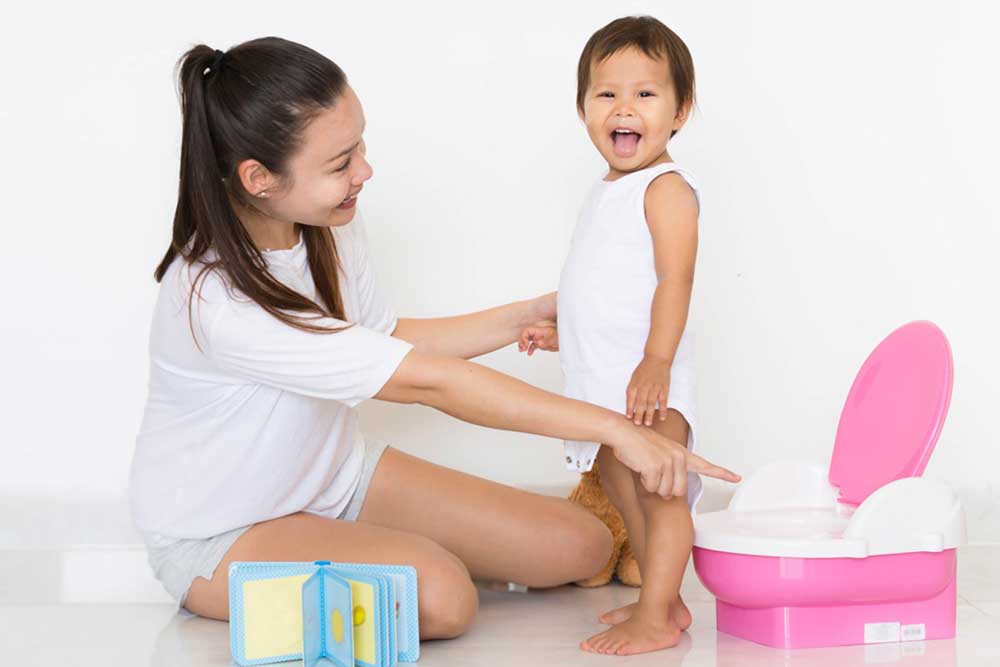Potty training is one of the biggest milestones of childhood, and one that many parents can’t wait to happen. Potty training happens at different times and speeds for every child, so there is no one-size-fits-all approach for it. In this article, we’ll break down the 12 signs that your child is finally ready for potty training and then explore some tips for having a successful potty training adventure and transitioning your child into toddler boy pants.
Signs Your Child Is Ready for Potty Training
Most children are ready to begin potty training around the age of 2, but it varies a little from child to child. Usually, it’s best to wait until your child expresses an interest in potty training. You want them to be a willing participant, after all! Potty training combines a toddler’s emerging independence with their desire to please and mimic adults, as well as their developing motor skills.
There are many different ways that your child might indicate they are ready for potty training. Many children will present multiple signs in some combination, but most won’t exhibit all 12 signs. Here are some potential signs that your child might give if they are ready to start potty training:
- They can go an hour or two without a wet diaper.
- They sometimes awaken from a nap with a dry diaper.
- They complain about wet or dirty diapers and/or ask for their diaper to be changed when it is soiled.
- They pull at dirty diapers or have shown other body language signs that indicate they want to be changed.
- Their bowel movements are predictable and happen at regular times each day.
- They express interest in using the toilet or wearing underwear.
- They may try to follow you into the bathroom or ask to watch you use the restroom.
- They might tell you that they need to go pee or poop (sometimes after they have already soiled their diaper).
- They may begin hiding or otherwise trying to get privacy whenever they need to pee and poop.
- They have mentally made the connection between needing to poop or pee and using the restroom.
- They can get on a child-size potty chair and stay on it long enough to pee or poop and then get off the potty.
- They can pull down their pants on their own.
Tips for Potty Training Your Child
Once you determine that your child is ready for potty training, then you are probably wondering what you can do to make the process smoother for both you and your child. Here are some tips to make it a successful experience for both of you:
- Don’t start potty training when your child is undergoing a huge life change. These changes can be external events, such as adjusting to a new sibling or moving into a new house, or going through another developmental milestone like being weaned off breastfeeding or using the pacifier. Trying to potty train during a time of great change will stress out both you and your child and make it harder for potty training to stick. Wait until things have calmed down and then give it another go.
- Make potty training a positive experience. After all, you want your child to have a good association with potty training, not bad ones. Try to brainstorm some fun activities that you do together, such as creating a potty progress chart or decorating the potty chair with markers or stickers. You should also give your child plenty of praise and encouragement during the process, as well as small rewards to celebrate meeting certain milestones.
- Choose the right potty seat — not every toddler does equally well with the same type of seat. Some prefer a standalone potty chair, while others want a potty seat that affixes to a regular toilet. If you opt for the latter, make sure that it is securely fastened and won’t wiggle around and that you have a step stool they can use. An unstable potty seat can make a child feel unsafe and set back their potty training journey.
- Dress them in the right clothes to facilitate bathroom usage. Overalls and clothes with lots of buttons may look adorable, but they’re also hard to remove and can result in an accident on the way to the toilet. Instead, put your child in simple clothes that are easy to remove at a moment’s notice, such as comfy and cute toddler girl leggings. Some children also do well with pull-ups, which can help them make the transition from diapers to full-time potty use while protecting against accidents.
- Start with bowel training, which refers to potty training while pooping. Children may not grasp the difference between pooping and peeing at first, and since everyone poops sitting down, it’s often easier to start with that. Once they are pooping in the toilet regularly, you can explore the difference between pooping and peeing and (if appropriate) work with your child on peeing while standing up.
- Be prepared for potty training regression along the way. It’s totally normal for your child to have to switch back to diapers for days, or even weeks, at some point during the potty training process. Don’t shame them for this. Instead, be supportive of them anyway. They will eventually get back on the potty, even if it feels like they won’t, so don’t rush things. Pay attention to their cues and start potty training again when they are ready for it.
- Stay patient with your child. It can be really frustrating when you have to mop up yet another pile of pee or put in yet another laundry load. While this frustration is totally understandable, try not to show it around your child. They will pick up on your emotional cues, which can make regression worse and ultimately delay their potty training. Patience is key when it comes to successful potty training.
Good luck with potty training your child — and remember that even if it feels impossible, it will happen eventually! Follow these tips to make potty training a pleasant experience for your child.

